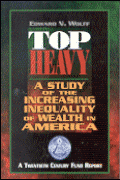Studies in this week’s Hutchins Roundup find that wealth of typical middle-class household has not returned to pre-recession levels, reasons for leaving a job during mass layoffs affect earnings, and more.
Want to receive the Hutchins Roundup as an email? Sign up here to get it in your inbox every Thursday.
Wealth of typical middle-class family is below pre-recession levels
Using Survey of Consumer Finance and Internal Revenue Service data from 1962-2016, Edward Wolff of New York University documents the trends in the wealth of the middle class, focusing particularly on the effects of the Great Recession and its aftermath. He finds that between 2007 and 2010, median wealth declined by 44 percent, likely due to the relatively high indebtedness of middle-class families and the importance of houses in their portfolios. Median wealth rebounded from 2010-2016 by 28 percent, but it didn’t fully recover. Overall wealth inequality, as well as racial and age disparities, rose substantially between 2007 and 2016. Over this time period, African Americans and Hispanics experienced larger wealth declines than whites, and younger households experienced larger wealth declines than older households.
During mass layoffs, reasons for leaving a job affect earnings
Existing research that uses administrative data suggests that workers who lose their job during mass layoffs suffer persistent earnings losses. Incorporating survey data that reveals workers’ reasons for leaving their jobs, Aaron Flaaen of the Federal Reserve, Matthew Shapiro of the University of Michigan, and Isaac Sorkin of Stanford find that workers who attribute their separation to the firm’s economic distress experience large and persistent earnings losses. However, workers who say they quit to take another job have earnings gains relative to workers who do not leave. Whether the worker separated from a firm actually experiencing economic distress also makes a difference in future earnings. In particular, workers who attribute their separation to the firm’s economic distress are better off (their earnings losses are smaller) if the firm they are leaving is actually contracting. In contrast, workers who quit to take a new job are worse off (their earnings gains are smaller) if the firm they are leaving is contracting.
Deregulating US banking markets leads to higher industry productivity growth
John (Jianqiu) Bai of Northeastern University, Daniel Carvalho of Indiana University, and Gordon Phillips of Dartmouth argue that lifting restraints on interstate banking between the early 1970s and early 1990s boosted industry productivity growth. Using various state-level banking deregulations as a natural experiment, they find evidence that deregulation spurred banks to lend more to young, high-productivity firms, and shifted labor to more productive employers. Alternative mechanisms of deregulation, such as changes in local demand for credit, don’t explain the growth of these young, high-productive firms, they say. The authors estimate that this reallocation translates to industry output gains between 1.1 and 2.1 percent over about five years.
Chart of the week: Percentage of employed women working full time has changed little over past five decades

Quote of the week:
“Even as the Fed has proceeded with its tightening, overall financial conditions have eased…this paradoxical outcome is not entirely new…it is reminiscent of the Fed policy tightening in the 2000s – the phase that spawned the now famous ‘Greenspan conundrum.’ Then, overall financial conditions hardly budged, and in some respects eased, as the Federal Reserve progressively raised rates. The experience contrasted sharply with previous tightenings, not least the one in 1994. At that time, long-term rates soared, the yield curve steepened, asset prices fell, corporate spreads widened and EMEs [emerging market economies] came under pressure. Why such a difference?” says Claudio Borio, head of the BIS Monetary and Economic Department.
“The answer may lie partly in the macroeconomic backdrop…[M]arket participants today are anticipating a future of even lower interest rates and possibly inflation than the central bank has communicated. Less appreciated perhaps, the very mix of gradualism and predictability may also have played a role. The pace of tightening has slowed across episodes, and it is now expected to be the slowest on record. And… the central bank has made every effort to prepare markets and to indicate that it will continue to move slowly. Indeed, today’s experience is reminiscent of the repeated reassurance of the 2000s’ “measured pace”, except that the adjustment has been, if anything, even more telegraphed. If gradualism comforts market participants that tighter policy will not derail the economy or upset asset markets, predictability compresses risk premia. This can foster higher leverage and risk-taking. By the same token, any sense that central banks will not remain on the sidelines should market tensions arise simply reinforces those incentives. Against this backdrop, easier financial conditions look less surprising.”









Commentary
Hutchins Roundup: Middle-class wealth, job separation reasons and earnings, and more
December 7, 2017